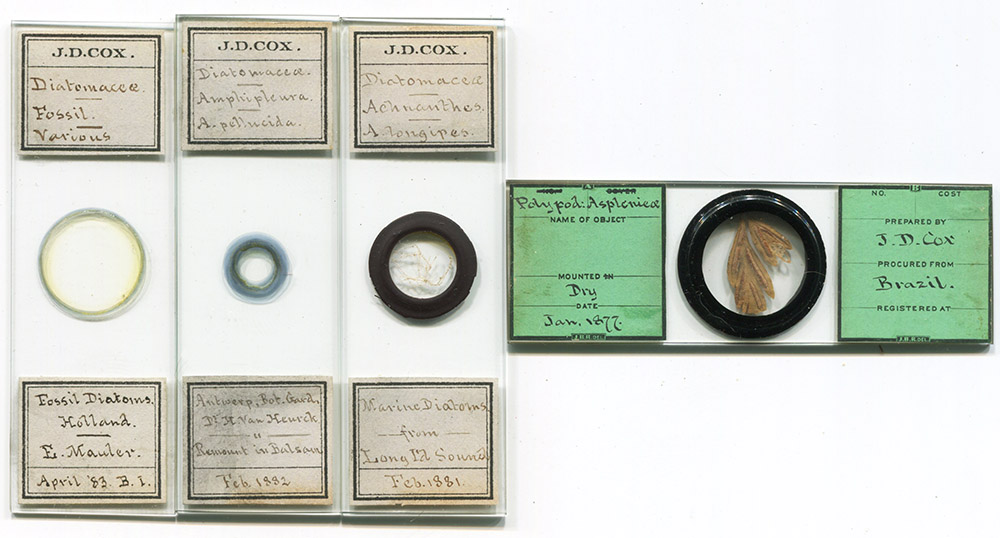
Figure 1. Four microscope slides that were prepared by Jacob D. Cox, dated between 1877 and 1883.
Jacob Dolson Cox, 1828 - 1900
Jacob Dolson Cox, Jr., 1852 - 1930
by Brian Stevenson, Charles M. Vorce, and Samuel P. Orth
last updated April, 2018
J.D. Cox was an important U.S. microscopist during the last quarter of the nineteenth century. In addition to numerous publications and presentations on the subject, he was twice President of the American Society of Microscopists, a Fellow of the Royal Microscopical Society, and the inspiration for Bausch & Lomb’s innovative “American Concentric” microscope. His youngest brother, Charles F. Cox, was also a notable microscopist, and is the subject of another essay on this site.
Professionally, Cox primarily worked as a lawyer, although he also served as Senator and Governor of Ohio, President of the University of Cincinnati and Dean of the University’s law school, U.S. Secretary of the Interior, Major General in the U.S. Army during the Civil War, and author of several important histories of that war.
His eldest son, J.D. Cox, Jr., was a mechanical engineer who became owner of a major drill bit manufacturing business. He also had an interest in microscopy.
The name James Dolson Cox was retained for several generations of this family. It was the name of the father of the man we are calling J.D. Cox, and was also the name of a son of the man we call J.D. Cox, Jr. Some historical records refer to each of them as Junior, while others refer to each as the Senior. In relation to microscopy, though, the man who lived from 1828-1900 is known as simply J.D. Cox, and his son was Junior.

Figure 1.
Four microscope slides that were prepared by Jacob D. Cox, dated between 1877 and 1883.
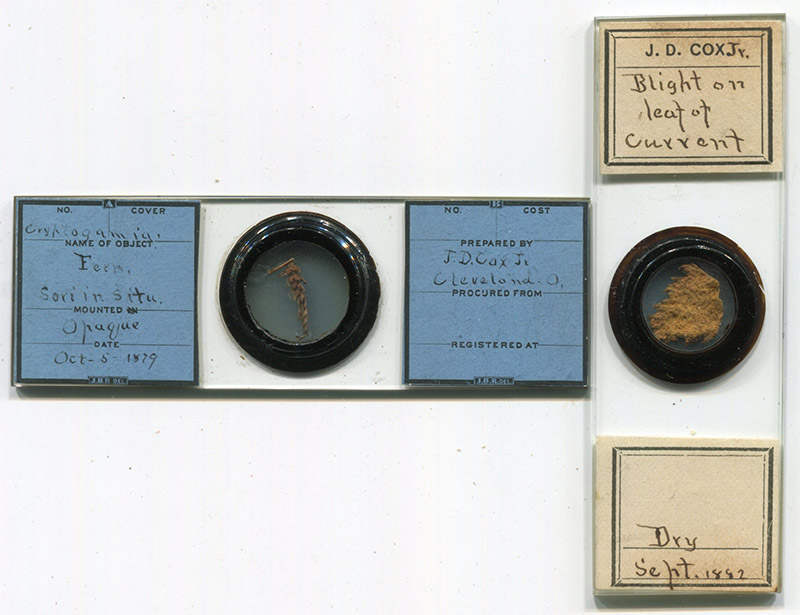
Figure 2.
Two microscope slides by J.D. Cox, Jr. Both are dry-mounted botanical subjects. For the slide on the left, he used the same type of off-the-shelf label as did his father for the slide shown in Figure 1. It is dated October 5, 1879. The slide on the right, made in September, 1882, used one of his father’s custom-printed labels, with “Jr.” added in handwriting.
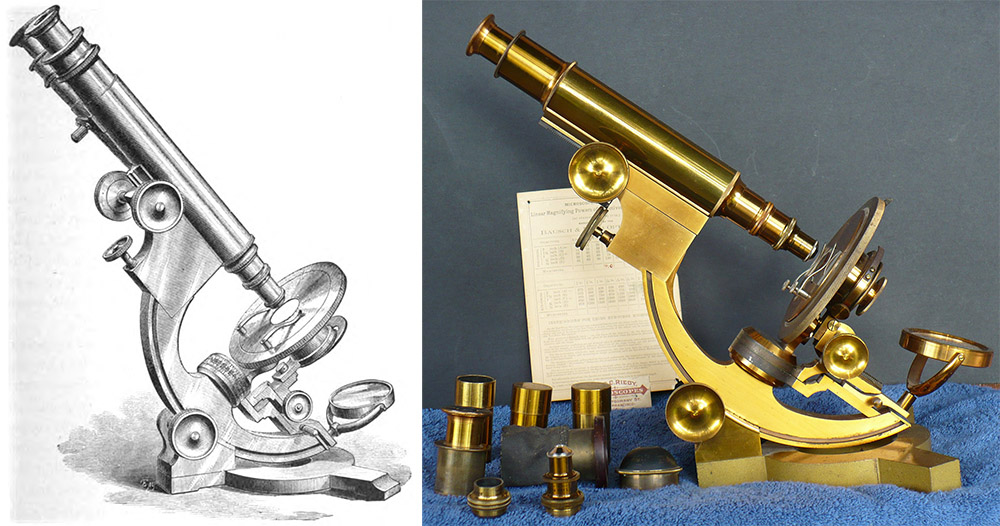
Figure 3.
“The American Concentric Microscope was first made at the suggestion of the Hon. J.D. Cox, by the Bausch and Lomb Optical Company, and is constructed on the principle of the sliding, concentric motion of the body. Its main advantage lies in the fact that its centre of gravity remains at about the same point over and close to the base with any inclination of the body and thus insures extreme stability”, quoted from George E. Davis’ “Practical Microscopy”, 1889. The design arose from a presentation that Cox made at the 1883 meeting of the American Microscopical Society. The engraving on the left is taken from Davis’ book. The image on the right is adapted for nonprofit, educational purposes from https://digital.lib.ecu.edu/22080.
A biography of J.D. Cox that emphasized his activities as a microscopist was written in 1901 by his colleague Charles M. Vorce. Samuel Peter Orth included a biography of J.D. Cox, Jr., in his 1910 A History of Cleveland, Ohio. Both are reprinted below, with limited editing for clarity:
Jacob Dolson Cox, by C.M. Vorce, from The Transactions of the American Microscopical Society, 1901:
Jacob Dolson Cox was born at Montreal, Ontario, October 27th, 1828. His father, a resident of New York City, and an architect by profession, was then living in Montreal where he was engaged in supervising the construction of the roof, etc., of Notre Dame Cathedral which he had designed, and upon the completion of which he returned to his home in New York City, where the boyhood years of the subject of this memoir were passed.
In 1846 Jacob Dolson Cox entered Oberlin College at Oberlin, Ohio, from which institution he graduated in 1851, receiving the degree of Master of Arts. In 1877 the degree of Doctor of Laws was conferred upon him by Yale College. He married Mrs. Helen Finney Cochran, widow of Prof. William Cochran and daughter of president Finney of Oberlin College, and in September, 1851, he accepted the position of superintendent of schools in Warren, Ohio, which position he held until 1854, and in the meantime studied law and was admitted to the bar. In 1859 he was elected to the senate of Ohio, in which he served during the years 1860 and 1861.
Upon the breaking out of the civil war and almost immediately after the firing upon Fort Sumter, he was appointed by Gov. Dennison, Brigadier General of Volunteers and was placed in charge of Camp Dennison, near Cincinnati, which was the great receiving and distributing camp for volunteers, and while in command of the camp he displayed great efficiency in the organization of the troops and in all the duties connected with the responsible position which he held. In July, 1861, he was assigned to service in the field, drove Wise out of the Kanawha Valley, West Virginia, and took a prominent part in the battles of South Mountain and Antietam, in which he commanded the 9th army corps. In the Atlanta and Franklin and Nashville campaigns Gen. Cox commanded the 23d army corps, and in 1864 he was commissioned Major General of volunteers.
In 1865 Gen. Cox was elected governor of Ohio, in which office he served during the years 1866 and 1867, and at the expiration of his term moved to Cincinnati and resumed the practice of law.
In March, 1869, Gov. Cox was appointed Secretary of the Interior by President Grant, and filled this position with distinguished credit until November, 1870, when he resigned, and returning to his home in Cincinnati, Ohio, again resumed the practice of law.
Soon after assuming his portfolio in Pres. Grant's cabinet, Gov. Cox was confronted with the practice then prevailing, of levying assessments upon the department officials and clerks for political purposes. To this Gov. Cox was inflexibly opposed, and was supported in his opposition by Pres. Grant, who assured him that the practice should no longer be enforced in the Interior Department. In September, 1870, however, during his temporary absence from the capitol, certain prominent politicians collected assessments from certain employees in the Interior Department, against the will of the employees. Upon learning of this, Sec. Cox became highly incensed and resigned his portfolio, taking the ground that if his views could not prevail in the conduct of the Interior Department he would have nothing to do with it. His resignation was reluctantly accepted by Pres. Grant, who personally sympathized with the views of Gov. Cox, but seemed to have been unable to control the clique of eminent politicians, who, themselves holding high offices under the government, were fully in accord with the system of political assessments.
In 1873 Gov. Cox was appointed president of the Toledo and Wabash Railroad Co. and removed to Toledo, Ohio. He remained as president and receiver of this R.R. until 1878.
In 1876 he was elected to congress from the Toledo District, and served as Congressman until March, 1879. Upon the expiration of his congressional term, Gov. Cox retired from politics and thereafter declined to take any active part therein.
In 1878 he removed to Cincinnati, soon after becoming Dean of the Cincinnati Law School, which position he held until 1897, when he resigned his position, retired from active business and removed to Oberlin, Ohio, where he resided until his death, which occurred at Magnolia, Mass., on August 4th, 1900. He was president of the University of Cincinnati from 1885 to 1889.
It was about the time of his removal to Toledo (ca. 1873) that Gov. Cox became interested in microscopy, which, as many other eminent microscopists have done, he first adopted as a recreation. His first microscopical studies were upon fresh water forms, particularly in the class rotatoria; but as might naturally be expected he speedily became interested in the study of the diatomaceae, to which his chief attention from that time forward was given. In his microscopical studies Gov. Cox displayed that painstaking thoroughness and striking power of logical analysis which he displayed in all his works in every walk of life. Almost at the beginning of his work with the microscope Gov. Cox adopted a system of keeping notes of his work and observations, which eventually grew to remarkable proportions. Among his belongings which he left at his decease, were some twenty or more note books completely written and filled with the records of observations, drawings and notes of his conclusions and deductions, all carefully dated and neatly written out, which work alone would seem to have been sufficient to absorb all the leisure time that one man would be able to devote to such work. In addition to this, however, he had made an almost complete card catalogue of the diatomaceae comprising the nomenclature and synonymy of each species, references to leading works in which it is figured and described, and Maltwood finder references to specimens of that particular form in slides among his own collection, which numbered some thousands of slides. In addition to contributing articles at intervals to the microscopical journals. Gov. Cox contributed several important papers to the (Proceedings of the American Microscopical Society).
In 1871 Gov. Cox took up the subject of photo-micrography, and in 1875 began making the series of photo-micrographs of diatomaceae so well known to many members of the society. Of this series of photo-micrographs, several hundred in number, Gov. Cox kept the same careful record as of all his other work with the microscope. His note books show the date when each negative was made, with full particulars concerning the object, illumination, apparatus employed, photo-micrographic technique, etc. Prints from this carefully numbered series of negatives were distributed by him to all the leading authorities on the diatomaceae. As a result of this work Gov. Cox received at the Antwerp exposition in 1891 the gold medal awarded for the greatest excellence in micrography.
In 1881 Gov. Cox was elected a fellow of the Royal Microscopical Society, and in August, 1882, was elected a member of (the American Society of Microscopists) at the Elmira meeting.
At the Chicago meeting in 1883 he was present and contributed a brief paper descriptive of the modification devised by him of the Wales Microscope stand, which modification became known as the "Concentric" stand.
At this meeting he was nominated and elected president of the society for the next meeting, which was held at Rochester in 1884. His presidential address at the Rochester meeting embraced a masterly discussion of the Tolles-Wenham controversy over the angular aperture of objectives used with balsam mounts. No one who had followed that lengthy and acrimonious dispute can fail to admire the clear, logical and exhaustive, yet brief, analysis of the arguments pro and con and the very numerous errors so strenuously maintained by the opponents of the "extra" balsam angle during the years when that unfortunate controversy dragged its slow length along through the literature of microscopy.
At the same meeting, Gov. Cox read an interesting paper on photomicrography with high powers, which displayed not only a thorough acquaintance with the subject and great experience in the work, but served as a text around which animated discussion was waged for the next two or three meetings, the views maintained and the practice advocated by Gov. Cox in that paper being finally vindicated by demonstrations afforded by the work of several other well known and active members of the society.
At the Cleveland meeting in 1885, Gov. Cox read a second paper on the subject of photo-micrography with high powers.
At the Chautauqua meeting in 1886 Gov. Cox, in collaboration with Mr. W.H. Walmsley, conducted a practical exhibition of photo-micrographic work which was of great value in familiarizing many interested members of the society with the technique and manipulation essential in that class of work, which at that time was rapidly growing in favor.
At the Washington meeting in 1892, Gov. Cox was a second time elected president of the society, and presided at the Madison meeting in 1893. In the intervening years he contributed to the society other valuable papers, one of the most painstaking being his paper read at the Detroit meeting in 1890 on the classification of the diatoms.
After 1895 he practically ceased work with the microscope, fearing its effect upon his eyes, but his interest in microscopy and the study of natural history by the aid of the microscope continued unabated during his life. His accumulation of careful and minutely detailed records, not only served as valuable helps to Gov. Cox in his work, but afforded the means by which the path he followed and the steps he took in his investigations can be accurately followed and fully understood by one who now reads the same.
During the last few years of his life, Gov. Cox, in company with his son, J.D. Cox, Jr., of Cleveland, spent several weeks each summer in yachting upon the New England coast, sometimes accompanied by other relatives and friends. During these periods Gov. Cox kept a careful log of their daily wanderings, noting the barometer reading, course of winds, distances sailed, points visited, etc., with all the careful attention to detail which characterizes the most experienced ship master.
His wide experience as an officer combined with his habits of exhaustive research and his power of keen analysis fitted him especially for the work of a military critic and historian, in which Gov. Cox attained a high repute. His reviews of military works in The Nation alone would fill several volumes and are marked by charity, lucidity and original contributions to history and the science of war. He wrote the articles "Atlanta" and "The March to the Sea," "Franklin and Nashville" for the Scribner Campaign Series in 1881 and 1882; several articles for Battles and Leaders of the Civil War published in 1884-1888; The Battle of Franklin, of which magnum pars fuit, in 1897; and Military Reminiscences of the Civil War in 1900. He also prepared an admirable analysis and exceedingly clear exposition of the facts in the Fitz John Porter Case, which he published in 1882, during the time when persistent efforts were being made in congress for the rehabilitation of General Porter.
In the outset of his studies at Oberlin College, Gov. Cox had intended to enter the ministry, and he pursued his theological studies for some time. Eventually, however, he seemed to doubt, probably without sufficient reason, his fitness for the ministry and gave up the idea of a clerical career. It is likely, however, that his theological studies accentuated and intensified the natural broad Christianity of his character, which during all of his varied and illustrious career was one of the potent features of attraction which so deeply endeared him to all who became well acquainted with him. His personality was attractive and none who met him can fail to remember his tall and striking appearance, his rich sonorous voice, and�the peculiarly frank and friendly expression of his face.
Jacob Dolson Cox, Jr., by Samuel P. Orth, from A History of Cleveland, Ohio, 1910:
Jacob Dolson Cox (Jr.) is now living retired but was formerly manager of the Cleveland Twist Drill Company and is still financially interested in the enterprise, his official connection therewith being that of director and vice president. He comes of a prominent and well known family of this part of the state but it has been his individual merit that has gained for him the enviable regard in which he is uniformly held. He was born in Warren, Ohio, May 15, 1852, and is a son of the Hon. Jacob D. Cox, a native of New York city. Coming to Ohio in early life, Hon. J.D. Cox pursued his education in Oberlin College and later settled in Warren, where he engaged in the practice of law. He soon became recognized as one of the most learned lawyers before the Ohio bar, and his intellectual force and ability carried him into important relations outside the strict path of his profession. At the time of the Civil war he espoused the cause of the Union and served in the army with the rank of major general. He became an influencing factor in the political circles of Ohio, first representing his district in the state senate, while later he was honored by election to the governorship of this commonwealth. National honors later came to him in his appointment as secretary of the interior in President Grant’s cabinet. The latter portion of his life was spent as dean in the Cincinnati Law School. He married Helen Finney, whose father, Charles G. Finney, was the dominating spirit of Oberlin College until his death. The demise of Hon. J.D. Cox occurred August 4, 1900, at Magnolia, Massachusetts, but his widow is still living at the age of seventy-eight years.
Jacob Dolson Cox of this review pursued his early education in the public schools of Warren, Ohio, and at the age of seventeen years came to Cleveland. Here he entered the employ of the Cleveland Iron Company to learn the rolling mill business. He worked in every capacity, including that of machinist, roll turner, roller, puddler, etc., and was thus employed until the fall of 1875. He also spent some time as a machinist with the old Cuyahoga Steam Furnace Company on marine engine work and was employed on the twin screw steamer Amazon, which was the first of the kind on the lakes. He returned home in 1875 and took up the study of mechanical drawing and kindred branches.
In June, 1876, he embarked in business on his own account, purchasing a half interest in the business of C.C. Newton of Dunkirk, New York, who was making twist drills and tools. The firm then became Newton & Cox and a removal was made to Cleveland in September, 1876. In June, 1880, Mr. Cox purchased his partner’s interest. The success of this venture was immediate from the start. At the time of removal to Cleveland the firm had but one man and one boy in their employ and something of the rapidity and wonderful growth of the business is indicated in the fact that in September, 1907, the company’s employees numbered eleven hundred men. The drill manufactured is used in machine shops throughout the world, being one of the most successful implements of this character ever placed upon the market. Its sale, therefore, has covered every civilized country and the volume of business makes this one of the most important industries of Cleveland and the middle west. While Mr. Cox is now retired from the active management to which he formerly devoted many years, he is still one of the directors and the vice president of the company and his connection therewith insures him a most gratifying and substantial annual income.
He is also a director of the Cleveland Trust Company and a member of its executive committee. He retired from active business on the 1st of January, 1904. In the fall of 1880 F. F. Prentiss had been admitted to a partnership under the firm style of Cox & Prentiss and when Mr. Cox retired from active management in January, 1904, the business was incorporated under the name of the Cleveland Twist Drill Company.
In 1878 occurred the marriage of J.D. Cox and Miss Ellen Prentiss, daughter of Judge S.B. Prentiss. Their children were: Samuel Houghton, who was born in 1879 and is now with the Cleveland Twist Drill Company; Jacob D., born in 1881; and Jeanette Prentiss (born in 1886).
Mr. Cox is very fond of golf, boating, and motoring, and has also spent considerable time in travel. He likewise finds keen interest in photography and microscopic studies. His interests, however, have been by no means confined to those things which relate only to his own success, pleasure or welfare. He has been a cooperant factor in various plans for the city’s good, has always been active in the Chamber of Commerce, becoming one of its original members, and was at one time its first vice president. In 1892 he was a member of the Committee on the Promotion of Industry, which committee in 1893 was merged with the old Board of Trade, forming the present Chamber of Commerce. In all public as well as private connections Mr. Cox has looked beyond the exigencies of the moment to the possibilities of the future and has labored for continuous as well as temporary progress and advancement. He is a trustee of the Case School and is a member of the American Society of Mechanical Engineers. He likewise belongs to the Engineers Club of Cleveland and the Engineers Club of New York city, is a member of the Loyal Legion and of the Society of Mayflower Descendants of Ohio and New York, while his appreciation of social amenities is indicated in his connection with the Union, Euclid, and Country Clubs. His labors throughout his entire life have been of far-reaching effect, the entire community feeling the stimulus of his efforts, for his nature has ever been too broad to exclude that service which every individual owes to his city and that interest which he should feel in every movement or plan promulgated for the public good.
(J.D. Cox, Jr., died on February 23, 1930, in Pasadena, California)
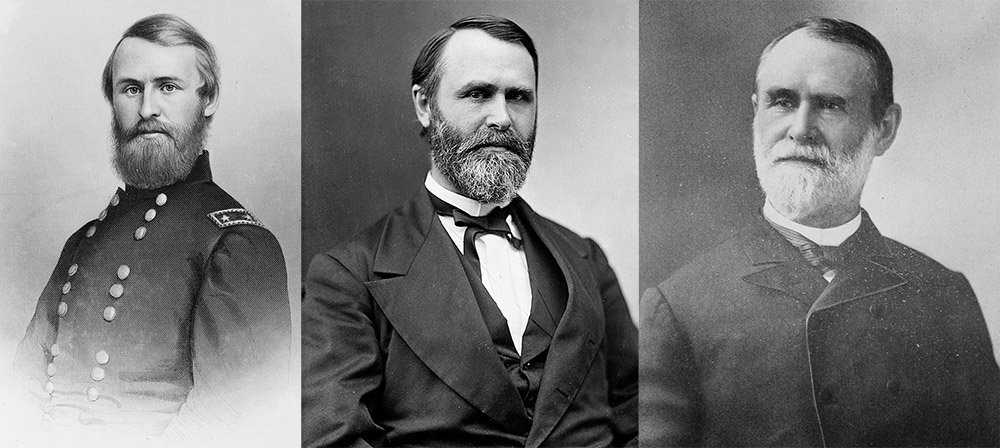
Figure 4.
Jacob D. Cox. Left and center, ca. 1864 in and out of uniform, while serving as a US Civil War Major General. Right, near the end of his life, from his 1901 Transactions of the American Microscopical Society obituary.
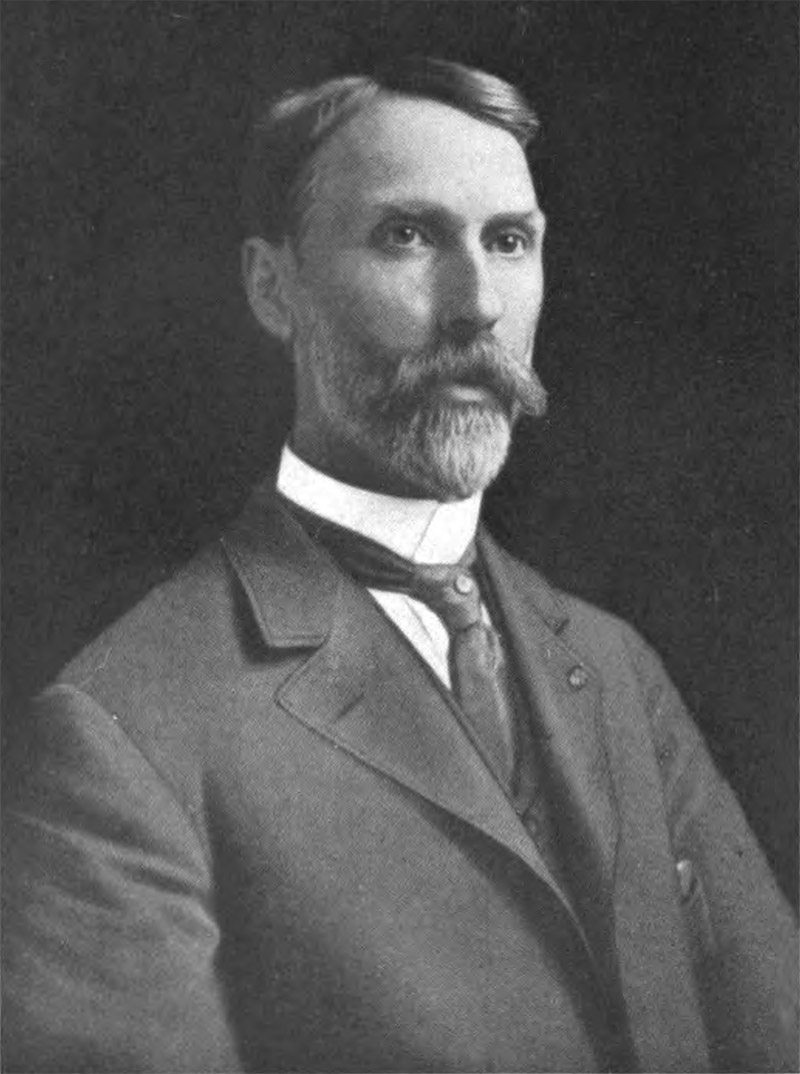
Figure 5.
Jacob D. Cox, Jr., ca. 1910, from Orth’s biography.
Resources
Davis, George E (1889) Practical Microscopy, W.H. Allen and Co., London, pages 56-58
Orth, Samuel Peter (1910) Jacob Dolson Cox, in A History of Cleveland, Ohio, Vol. 2, S.J. Clarke, Chicago, pages 36-39
Vorce, Charles M. (1901) Jacob Dolson Cox, Transactions of the American Microscopical Society, Vol. 22, pages 197-202
U.S. census and other records, accessed through ancestry.com
www.microscope-antiques.com/concentric.html (accessed March, 2018) The Bausch & Lomb “American Concentric Microscope”